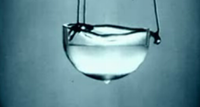
Photo from wikipedia
We study the energy-level evolution and ground-state cooling of mechanical resonators under a synthetic phononic gauge field. The tunable gauge phase is mediated by the phase difference between the $\mathcal{PT}$-… Click to show full abstract
We study the energy-level evolution and ground-state cooling of mechanical resonators under a synthetic phononic gauge field. The tunable gauge phase is mediated by the phase difference between the $\mathcal{PT}$- and anti-$\mathcal{PT}$-symmetric mechanical couplings in a multimode optomechanical system. The transmission spectrum then exhibits the asymmetric Fano line shape or double optomechanically induced transparency by modulating the gauge phase. Moreover, the eigenvalues will collapse and become degenerate although the mechanical coupling is continuously increased. Such counterintuitive energy-attraction, instead of anti-crossing, attributes to destructive interferences between $\mathcal{PT}$- and anti-$\mathcal{PT}$-symmetric couplings. We find that the energy-attraction, as well as the accompanied exceptional points (EPs), can be more intuitively observed in the cavity output power spectrum where the mechanical eigenvalues correspond to the peaks. For mechanical cooling, the average phonon occupation number becomes minimum at these EPs. Especially, phonon transport becomes nonreciprocal and even ideally unidirectional at the EPs. Finally, we propose a heating-resistant ground-state cooling based on the nonreciprocal phonon transport, which is mediated by the gauge field. Towards the quantum regime of macroscopic mechanical resonators, most optomechanical systems are ultimately limited by their intrinsic cavity or mechanical heating. Our work revealed that the thermal energy transfer can be blocked by tuning the gauge phase, which supports a promising route to overpass the notorious heating limitations.
Journal Title: Physical Review A
Year Published: 2021
Link to full text (if available)
Share on Social Media: Sign Up to like & get
recommendations!